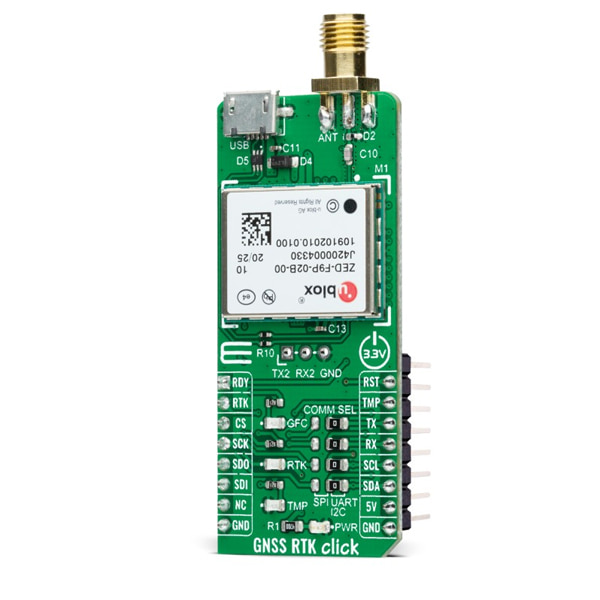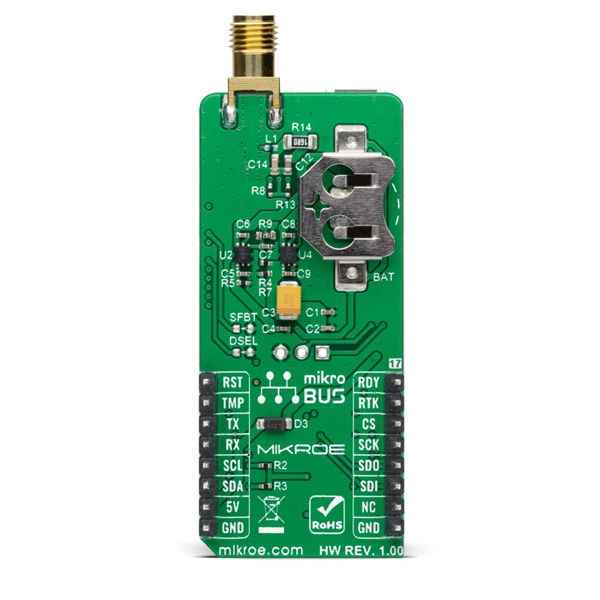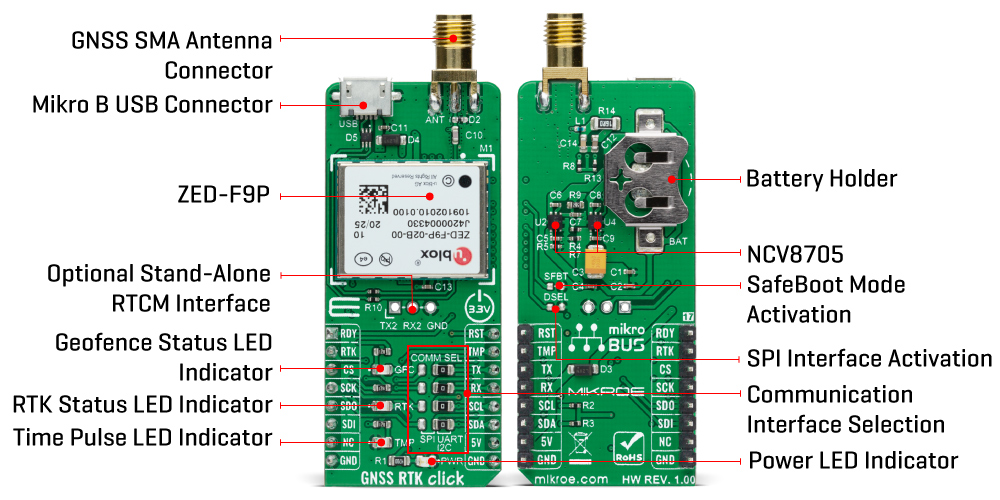GNSS RTK 모듈 -ZED-F9P
(GNSS RTK CLICK)


개요
특징
-
GNSS RTK Click is based on the ZED-F9P, a multi-band GNSS module with integrated multi-band RTK technology offering centimeter-level accuracy from U-blox. This GNSS receiver can receive and track multiple GNSS constellations. Thanks to the multi-band RF front-end architecture, all four major GNSS constellations (GPS, GLONASS, Galileo, and BeiDou) plus SBAS and QZSS satellites can be received concurrently. The combination of GNSS signals from multiple frequency bands (L1/L2/L5) and RTK technology allows the ZED-F9P to achieve centimeter-level accuracy in seconds. Receiving more satellite signals at any given time maximizes the availability of centimeter-level accuracy even in challenging environments such as in cities.

The ZED-F9P comes with built-in support for standard RTCM corrections, routed on the additional header, unpopulated by default, available as an optional stand-alone RTCM input interface that can not be used as a host interface. It also ensures the security of positioning and navigation information by using secure interfaces and advanced jamming and spoofing detection technologies.
GNSS RTK Click communicates with MCU using the UART interface at 9600 bps as its default communication protocol with the option for the users to use other interfaces such as SPI and I2C if they want to configure the module and write the library by themselves. The interface selection between UART/SPI can be performed by positioning SMD jumpers labeled as COMM SEL to an appropriate position. When selecting the SPI communication, with the correct selection of the COMM SEL jumper, it is necessary to set the jumper to DSEL to configure the interface pins as SPI. In the default state, the jumper labeled as DSEL is unpopulated. The receiver also can enter a safe boot mode. If the jumper labeled as SFBT is populated and the SAFEBOOT pin is low at Power-Up, the receiver starts in safe boot mode and GNSS operation is disabled.
The USB interface, compatible with the USB version 2.0 FS (Full Speed, 12 Mbit/s), can be used for communication as an alternative to the UART. The USB port can be used as a power supply if you need the Click board™ to be a standalone device. In the case of the main supply failure, the module can use a backup supply voltage from a connected battery. Backup voltage supplies the real-time clock and battery-backed RAM and enables all relevant data to be saved in the backup RAM to allow a hot or warm start later.
In addition to these features, it also has several GPIO pins. RDY pin routed to the AN pin of the mikroBUS™ socket is used as a communication indicator when bytes are ready to be transmitted, the RST pin routed on the PWM pin of the mikroBUS™ socket provides the ability to reset the receiver, and the TMP pin, with LED indicator, routed on the INT pin of the mikroBUS™ socket provides clock pulses with configurable duration and frequency.
RTK pin routed on the RST pin of the mikroBUS™ socket, alongside with LED indicator labeled as RTK, provides an indication of the RTK positioning status. When LED is blinking, it indicates that a valid stream of RTCM messages is being received, but no RTK fixed mode has been achieved. When the LED is constantly lit, the LED indicates that RTK mode has been achieved. It also has another LED indicator labeled as GDC that indicates the current geofence status as to whether the receiver is inside any of the active areas. This feature can be used, for example, to wake up a sleeping host when a defined geofence condition is reached.
GNSS RTK Click possesses the SMA antenna connector, and it can be used for connecting the appropriate antenna that Mikroe has in its offer, such as GPS Active External Antenna. This antenna is an excellent choice for all GSM/GPRS applications with a frequency range of 1595.42 ± 25MHz.
This Click board™ is designed to be operated only with a 5V logic voltage level. A proper logic voltage level conversion should be performed before the Click board™ is used with MCUs with different logic levels.
-
Type GPS+GNSS Applications Can be used for machine control, ground robotic vehicles, and high precision unmanned aerial vehicles (UAV) applications On-board modules GNSS RTK Click is based on the ZED-F9P, a multi-band GNSS module with integrated multi-band RTK technology offering centimeter-level accuracy from U-blox Key Features High precission, centimeter-level accuracy, high update rate for highly dynamic applications, multi-band RTK with fast convergence times and reliable performance, and more. Interface I2C,UART,SPI,GPIO Compatibility mikroBUS Click board size L (57.15 x 25.4 mm) Input Voltage 5V